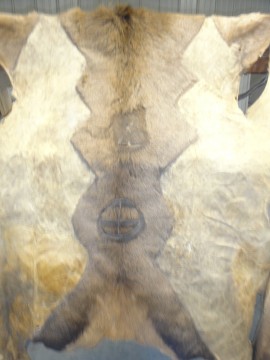
The Ponca Tribe’s recently reopened tannery revitalizes a centuries-old tribal craft that it hopes will serve as an economic boon, reported the World-Herald News Service.
The Ponca Tannery currently works with the hides of large game animals including cattle, deer, moose, buffalo and elk. Some profits from sales of the velvety buckskins and rawhides go toward maintaining and securing the future sustainability of the tribe’s bison herd on the northeastern Nebraska plains. Thus far in 2011, 60 hides have come in to be tanned, reported the World-Herald.
Big changes are in store for the new tannery, which originally began operations in 2008, aided in 2009 by a $250,000 grant from the Shakopee Mdewakanton Sioux Community of Minnesota. After a year, the business shut down. Learning from previous mistakes like a lack of financial resources and an unclear business plan, it reopened for business January 8, 2011, Kevin M. Schrader, the tannery’s manager, told Indian Country Today Media Network.
“The business originally focused on creating ceremonial robes, rugs and wall [art] out of the hides,” Schrader said. “However, we are now working toward owning the hide for its entire life cycle from hide to tanned leather to finished product, whether it be a robe, clothing, bags, quivers or shields with our focus split evenly between the needs of tribes and selling to the blackpowder/rendezvouz markets.”
The Ponca tanners practice brain tanning, a custom in which brain material is boiled down and rubbed into the hides to create a softer and thicker hide with a “spongier texture,” according to the tannery’s website (not yet fully operational, but soon to go live at www.poncatannery.com). The labor-intensive, chemical-free process is a science passed down by tribal elders. “It has been said that nothing quite equals the texture of a brain-tanned skin,” the tannery’s website states.
The hides are salted down, soaked, washed and hung by two people to dry out on a frame. Flesh is scraped away, and hair is brushed and trimmed for a uniform appearance. “Hand-stretching and fleshing add to the quality of the finished product,” states the website.
Twenty-year-veteran master tanner and supervisor Pat Wright works with his son, Steven Hoffman, and grandson Rico Four Kitten, carrying on the tribal tradition. “This gives me an opportunity to make money doing what I am trained to do and pass the tradition on to the next generations.”
While the tannery currently employs eight tribal members, Schrader said new plans will allow the tannery to hire a much larger workforce. The tannery can then “become profitable sooner and give our tribal members a sense of pride and gainful employment,” Schrader said.
© 1998 - 2011 Indian Country Today. All Rights Reserved To subscribe or visit go to: http://www.indiancountry.com
